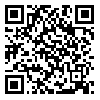Volume 7, Issue 4 (NOV 2022)
JNFS 2022, 7(4): 508-511 |
Back to browse issues page
School of Agricultural Sciences and Food Industries, Ardestan Branch of Islamic Azad University.
Abstract: (1975 Views)
Background: Astaxanthin is widely and naturally distributed in marine animals including, crustaceans, such as shrimp, crabs, and fish, such as salmon and trout. Methods: A total of 20 trout samples were collected from local market and were analyzed for astaxanthin via HPLC-UV. Analyte extraction was done by water, methanol, dichloromethane, and acetonitrile 4.5:85:5:45.5, v/v/v/v. Results: Despite the optimal conditions, analytical property of the method containing lower limit of quantitation (2.00 ng g-1) and upper limit of quantitation (1000 ng g-1), linearity (r2=0.992), and recovery (103%) were acceptable. The results showed the range of 105 ± 0.09 - 875 ± 0.020 ng g-1. Conclusion: The method was successfully used to quantify the target analytes in all trout samples.
Keywords: Astaxanthin, High performance liquid chromatography, Fish, Upper limit of quantification (ULOQ), lower limit of quantification (LLOQ)
Type of article: orginal article |
Subject:
public specific
Received: 2021/05/20 | Published: 2022/11/19 | ePublished: 2022/11/19
Received: 2021/05/20 | Published: 2022/11/19 | ePublished: 2022/11/19
References
1. Ambati RR, Phang S-M, Ravi S & Aswathanarayana RG 2014. Astaxanthin: sources, extraction, stability, biological activities and its commercial applications—a review. Marine drugs. 12 (1): 128-152.
2. Guerin M, Huntley ME & Olaizola M 2003. Haematococcus astaxanthin: applications for human health and nutrition. TRENDS in biotechnology. 21 (5): 210-216.
3. Higuera-Ciapara I, Felix-Valenzuela L & Goycoolea F 2006. Astaxanthin: a review of its chemistry and applications. Critical reviews in food science and nutrition. 46 (2): 185-196.
4. Hu J, et al. 2019. Extraction and purification of astaxanthin from shrimp shells and the effects of different treatments on its content. Revista Brasileira de Farmacognosia. 29 (1): 24-29.
5. Hussein G, Sankawa U, Goto H, Matsumoto K & Watanabe H 2006. Astaxanthin, a carotenoid with potential in human health and nutrition. Journal of natural products. 69 (3): 443-449.
7. Kumar PM, Naveen J, Janani R & Baskaran V 2021. Safety assessment and pharmaceutical effects of astaxanthin: An overview. Global perspectives on astaxanthin. 569-591.
8. Lim KC, Yusoff FM, Shariff M & Kamarudin MS 2018. Astaxanthin as feed supplement in aquatic animals. Reviews in aquaculture. 10 (3): 738-773.
9. Maciel EDS, et al. 2013. Relationship between the price of fish and its quality attributes: a study within a community at the University of São Paulo, Brazil. Food science and technology. 33 (3): 451-456.
10. Mezzomo N & Ferreira SR 2016. Carotenoids functionality, sources, and processing by supercritical technology: a review. Journal of chemistry. 2016.
11. Naguib YM 2000. Antioxidant activities of astaxanthin and related carotenoids. Journal of agricultural and food chemistry. 48 (4): 1150-1154.
12. Park JS, Chyun JH, Kim YK, Line LL & Chew BP 2010. Astaxanthin decreased oxidative stress and inflammation and enhanced immune response in humans. Nutrition & metabolism. 7 (1): 1-10.
13. Rapala J, Erkomaa K, Kukkonen J, Sivonen K & Lahti K 2002. Detection of microcystins with protein phosphatase inhibition assay, high-performance liquid chromatography–UV detection and enzyme-linked immunosorbent assay: Comparison of methods. Analytica Chimica Acta. 466 (2): 213-231.
14. Safavizadeh V, Shayanfar A, Ansarin M & Nemati M 2020. Assessment of the Alternaria mycotoxin Tenuazonic Acid in Fruit Juice Samples. Journal of microbiology, biotechnology and food sciences. 9 (6): 1162-1165.
15. Sawanboonchun J, Roy WJ, Robertson DA & Bell JG 2008. The impact of dietary supplementation with astaxanthin on egg quality in Atlantic cod broodstock (Gadus morhua, L.). Aquaculture. 283 (1-4): 97-101.
16. Vervoort RJ, Maris F & Hindriks H 1992. Comparison of high-performance liquid chromatographic methods for the analysis of basic drugs. Journal of Chromatography A. 623 (2): 207-220.
17. Yang Y, Kim B & Lee JY 2013. Astaxanthin structure, metabolism, and health benefits. Journal of human nutrition & food science. 1 (1003): 1-1003.
18. Yasir I & Qin JG 2010. Effect of dietary carotenoids on skin color and pigments of false clownfish, Amphiprion ocellaris, Cuvier. Journal of the world aquaculture society. 41 (3): 308-318.
| Rights and permissions | |
 |
This work is licensed under a Creative Commons Attribution-NonCommercial 4.0 International License. |





